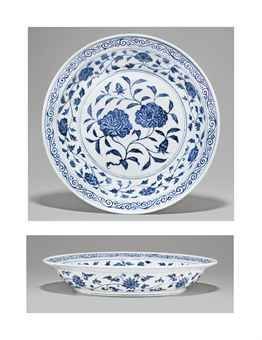A Very Rare Large Blue And White Dish. Yongle Period (1403-1425)
A Very Rare Large Blue And White Dish. Yongle Period (1403-1425). Photo: Christie's Images Ltd 2012.
The dish is finely potted with shallow rounded sides that rise to an everted rim, and is painted in underglaze blue of inky tone, enhanced by darker 'heaping and piling', with a leafy rose branch bearing two blossoms and two buds, below a band of peony meander in the well, and a band of classic scroll on the flat rim. A band of continuous lotus scroll encircles the exterior. 14¾ in. (37.5 cm.) diam. Estimate $150,000 - $250,000
Provenance: The Christer Löftgren collection, Sweden, acquired circa 1990.
Notes: This exquisitely painted dish represents the finest of Yongle blue and white, on which the vibrant blue of the cobalt is complemented by the pure white porcelain body, and the decorator has allowed considerable space around each decorative element to enhance the effect. It belongs to a group of particularly fine flat-rimmed dishes, all of approximately the same size, which are painted in the center with flower sprays dominated by two open blossoms. Two of these dishes, from the Qing Court collection of the Palace Museum, Beijing, are illustrated inThe Complete Treasures of the Palace Museum - 35 - Blue and White Porcelain with Underglaze Red (I), Hong Kong, 2000, p. 58, no. 55 and p. 61, no. 58. While these two Palace Museum dishes are decorated with different floral motifs, they share the same extraordinarily skillful painting. In the case of the dish no. 58, it also shares with the current dish the most elegant classic scroll around its flattened rim.
What makes the current dish especially rare is the fact that the flowers in the center of its interior are roses. These flowers are unusual on Chinese porcelain prior to the Qing dynasty, but do in fact begin to appear on blue and white as early as the Yuan dynasty. They can be seen on a small number of mid-14th century jars decorated with narrative themes from zaju drama. Three well-known examples incorporate roses in their decoration. These are the van Hemert jar, decorated with the arrival of Guiguzi from the story of Yue Yi tu Qi Qiguo (Yue Yi scheming against Qi); the jar formerly in the Manno Collection, decorated with a scene from Baihua Ting(The Hundred Flowers Pavilion); and the jar formerly in the British Rail Pension Fund, decorated with a scene from Meng Yuemei xie hen Jinxiang Ting (Meng Yuemei writes of her regrets in the Pavilion of Fragrant Brocade). In the case of these Yuan jars, the roses are simply included as part of the landscape, and can be identified by their thorns as well as by their buds and leaves. However, in the Yongle reign a new style of rose occasionally appears on well-painted blue and white porcelain. This rose is Rosa chinensis, or yuejihua in Chinese - literally 'last month flower', a reference to its long flowering season. On Yongle porcelain it is not shown with thorns, but its flowers, leaves, buds, and occasionally hips, are clearly depicted. It appears with other flowers in a number of minor bands on Yongle blue and white porcelains, such as the interior rim band on a large dish excavated from the Yongle strata at Jingdezhen in 1994, illustrated by the Chang Foundation in Imperial Hongwu and Yongle Porcelain excavated at Jingdezhen, Taipei, 1996, pp. 140-1, no. 38; as a scroll around the shoulder of a lidded jar, also excavated in 1994, illustrated op. cit., pp. 198-9, no. 68; and as one of four flowers on the exterior of a deep bowl, also excavated in 1994, illustrated op. cit., pp. 214-5, no. 76. A single rose, similar to those on the interior of the current dish, can be seen on a fragment of a bowl excavated at the site of the early Ming Palace at Nanjing, illustrated in A Legacy of the Ming, Hong Kong, 1996, p. 49, no. 53. A similar single rose is also painted on the side of a Yongle bowl, in the collection of the Palace Museum, Beijing, illustrated in The Complete Treasures of the Palace Museum - 35 - Blue and White Porcelain with Underglaze Red (I), Hong Kong, 2000, p. 73, no. 70. It is, however, very rare to find roses comprising the major decoration, as on the current dish.
Christie's. Fine Chinese Ceramics and Works of Art Part I. 13 - 14 September 2012, New York, Rockefeller Plaza

/https%3A%2F%2Fprofilepics.canalblog.com%2Fprofilepics%2F1%2F0%2F100183.jpg)
/https%3A%2F%2Fstorage.canalblog.com%2F03%2F02%2F119589%2F96711876_o.jpg)
/https%3A%2F%2Fstorage.canalblog.com%2F11%2F31%2F119589%2F94773502_o.jpg)
/https%3A%2F%2Fstorage.canalblog.com%2F20%2F83%2F119589%2F94772815_o.jpg)
/https%3A%2F%2Fstorage.canalblog.com%2F26%2F72%2F119589%2F75604929_o.jpg)
/https%3A%2F%2Fstorage.canalblog.com%2F59%2F60%2F119589%2F26458628_o.jpg)



/image%2F1371349%2F20240416%2Fob_2a8420_437713933-1652609748842371-16764302136.jpg)
/image%2F1371349%2F20240414%2Fob_83ee65_2024-nyr-22642-0954-000-a-blue-and-whi.jpg)
/image%2F1371349%2F20240414%2Fob_15808c_2024-nyr-22642-0953-000-a-blue-and-whi.jpg)
/image%2F1371349%2F20240414%2Fob_e54295_2024-nyr-22642-0952-000-a-rare-blue-an.jpg)